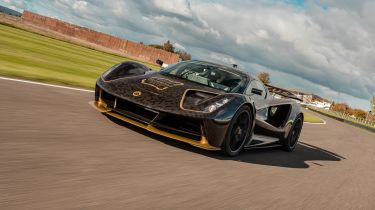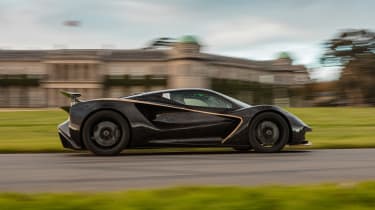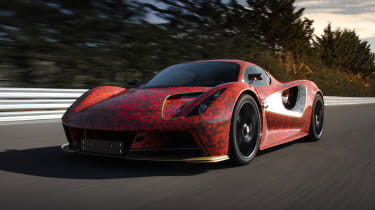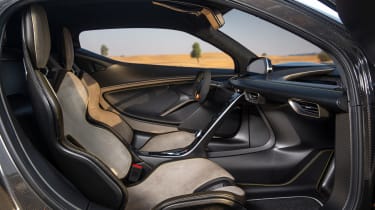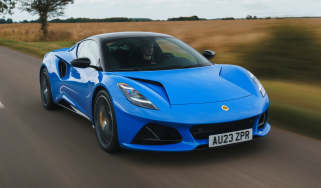New Lotus Evija makes appearance at Goodwood SpeedWeek
Upcoming all-electric Lotus Evija hypercar will tackle the Goodwood circuit, alongside a range of classic Lotus race cars
Lotus is steadily building anticipation for the market launch of the pure-electric Evija. The hypercar will make a dynamic appearance at this year’s Goodwood SpeedWeek, where it’ll tear around the festival’s circuit alongside a roster of classic Lotus Formula One racers.
For the event, Lotus has wrapped an Evija prototype in a stylised version of the black and gold livery worn by Mario Andretti’s Lotus 79 from the 1978 Formula One season. That F1 title-winning racer will also appear at the event, accompanied by other Team Lotus icons like Graham Hill’s Lotus 49, Emerson Fittipaldi’s Lotus 72-7 and Sir Stirling Moss’s Lotus 18.
Lotus’s rival for the Rimac C_Two will enter production later this year in a limited run of just 130 units, each priced £1.7 million. The Goodwood demonstration is the latest in a series of tidbits revealed about the hypercar’s performance capability since the project was announced. Previous to this demo run, the Norfolk-based supercar brand detailing the Evija’s five driving modes.
Each setting incrementally increases the level of performance supplied by the Evija’s pure-electric powertrain. The least aggressive mode is called “Range”, and it limits the car’s performance to ‘just’ 986bhp and 800Nm of torque, to maximise the distance the supercar can cover between charges.
“City” mode provides the same level of performance, but ramps up the car’s regenerative braking system – which Lotus says is better suited to urban environments. Both of these lesser settings also disengage the front motor for better efficiency.
“Tour” mode re-engages the hypercar’s front motor and therefore provides a significant bump in power, lifting the Evija’s output to 1,381bhp and 1,700Nm of torque. It also activates the car’s torque vectoring system to provide better cornering speed.
Stepping up again, “Sport” and “Track” mode increase the Evija’s output to 1,677bhp and 1,972bhp respectively. The latter setting also unlocks an increased level of torque vectoring and a Drag Reduction System: a system similar to that found on a Formula One racer which reduces the angle of attack of various aerodynamic surfaces in order to increase top speed.
Lotus Evija: design and platform
The Evija’s styling was penned by Lotus’s design director Russell Carr. It draws inspiration from Le Mans sports cars and Formula One racers, so it’s a significant departure from the firm’s current model range. Lotus also says the Evija debuts a new design language that will “evolve and reappear” on its future cars.
It’s based on a bespoke carbon-fibre monocoque chassis and cloaked in carbon-fibre body panels – the design of which were ultimately decided by aerodynamic performance. For example, the Venturi tunnels at the rear draw air through the body and increase downforce, while the LED tail-lights mimic afterburners on a fighter jet when illuminated.
An integrated front splitter, inspired by the Type 72 Formula One car, is designed to help cool both the front axle and the battery, which is located behind the seats. An active rear spoiler has also been integrated into the bodywork to improve aerodynamics and performance.
The Evija also features magnesium wheels that measure 20 inches up front and 21 inches at the rear. Carbon-ceramic brakes and Pirelli Trofeo R tyres are fitted as standard, while the in-board suspension (like that fitted to an F1 car) features adaptive dampers on each axle.
Lotus Evija: powertrain and battery pack
At the Evija’s heart is a complex drivetrain. Lotus says it develops a maximum of 1,972bhp and 1,700Nm – which is four and a half times more than the firm’s current flagship, the Evora 430. Such performance would make the Evija the world’s most powerful road car.
The electric powertrain features four electric motors – one for each wheel. As such, Lotus claims that the Evija will crack the 0–62mph sprint in less than three seconds. The firm also states that 0–184mph will be dealt with in under nine seconds, while the car’s top speed is in excess of 200mph.
What’s more, torque-vectoring technology will also distribute power to any two, three or four wheels to maximise performance. When the car is driving on track, Lotus says that the amount of power going to each wheel can be increased to maximise agility. It can deliver full performance on track for seven minutes – the equivalent to around four laps of Silverstone.
When it’s not being thrashed, the 70kWh battery, supplied by Williams Advanced Engineering, can cover 250 miles on a single charge – and it can recover its full capacity in just 18 minutes when plugged into a DC fast charger. The battery is also the first of its kind to be compatible with 800kW charging, although there are currently no such units available.
Lotus Evija: interior and infotainment
The cabin of the Lotus Evija is accessed via a pair of remote-operated dihedral doors, similar in function to those fitted to the McLaren 720S, and is trimmed almost entirely in carbon fibre. There are a pair of carbon-fibre-backed bucket seats with Alcantara pads for support and a pair of four-point racing harnesses in place of conventional three-point seat belts.
The rectangular steering wheel houses a range of buttons and dials, so the car’s functions can be easily operated on the move. Meanwhile, a floating centre console between the seats has additional controls for the media, climate and nose-lift systems. There’s just one digital display behind the steering wheel, although Apple CarPlay and Android Auto are available.
Lotus Evija: production and development
Production for customer examples of the Evija is due to begin later in 2020 on a new line at the firm’s home in Hethel, Norfolk. The new building sits directly beside the Lotus test circuit and will handle the assembly of all 130 examples of the British brand’s first electric hypercar.
The construction of the Evija facility comes at a time of great expansion at Lotus, made possible thanks to over £100 million-worth of investment from parent company Geely. Currently, 1,400 employees are based at Hethel – and the completion of the new factory has certainly eased the Evija’s development process. Previous images released by Lotus showed a prototype undergoing testing at the brand’s 2.2-mile test track, right next door to the car’s production line.
Key aspects of the Evija’s electrical system, such as its stability control and torque vectoring systems, were completed right at the end of the car’s development. Gavan Kershaw, British GT racing driver and Lotus’s Director of Attributes, says this ensures the Evija’s chassis will develop plenty of mechanical grip – and not simply rely on electronics to keep the suspension in check.
Kershaw said: “We’re currently evaluating the fundamentals of the chassis, to create the mechanical advantage before the other layers, such as the electronics, are added. It means we can really read the car. Later we can tune what we’ve gained as a mechanical advantage as we add layers. It’s the Lotus way – get the fundamentals right from the start and use baseline aerodynamics, suspension kinematics and geometry to feel the vehicle’s response.”
What's your favourite all-electric hypercar? Let us know in the comments below...
Find a car with the experts

